
ADVERTISEMENT
Remembering Full-Service Gas Stations: The Golden Age of Customer Care on the Road
ADVERTISEMENT
Introduction
Once upon a time, stopping at a gas station was more than just a quick fuel fill-up. Gas stations in the mid-20th century offered what is now considered a luxury—full service. Attendants would not only pump gas but also check oil, wash windows, inspect tire pressure, and even clean the car’s headlights. This personalized care brought a level of connection and service that is rare in today’s fast-paced, automated world. Let’s dive into the history of full-service gas stations, why this golden age faded, and where you can still find it today.
The Rise of the Full-Service Station
Full-service gas stations began gaining popularity in the 1920s and 1930s when the automobile industry was booming. As car ownership became more common, the demand for fuel stations grew, and with it, a market for quality customer service. At that time, gas stations were often affiliated with specific oil companies like Texaco, Shell, and Esso (now ExxonMobil). These companies encouraged stations to offer full-service options as a way to differentiate themselves from competitors and build customer loyalty.
In those days, stopping for gas meant more than just a fuel fill-up. Customers were treated to an experience that included a smile, small talk, and genuine care for their vehicle’s health. It wasn’t unusual for attendants to be dressed in crisp uniforms, complete with hats and ties, creating a sense of professionalism and pride in their work. This made a trip to the gas station feel almost ceremonial—a necessary pit stop on the road that doubled as a check-in for the car’s maintenance and cleanliness.
ADVERTISEMENT
What a Full-Service Stop Looked Like
For those who never experienced it, a full-service gas station stop was a well-orchestrated affair. As soon as a car pulled up, an attendant (or sometimes multiple attendants) would spring into action. Here’s a rundown of what typically happened:
- Fuel Pumping: The attendant would handle the pump, asking the customer how much gas they wanted or if they wanted it filled to the top.
- Oil and Fluids Check: While the gas was pumping, the attendant would pop the hood to check the oil level and add more if needed. They might also inspect other fluids like the windshield wiper fluid or coolant.
- Window Cleaning: Attendants would use a squeegee and cleaning solution to wash the front and rear windows, ensuring the driver’s visibility was crystal clear.
- Tire Inspection: Using a gauge, the attendant would check each tire’s air pressure, adding air if needed.
- A Friendly Chat: Attendants often knew regular customers by name, asking about their families or travel plans. This personal touch made the experience more enjoyable and established a community atmosphere at the station.
In many cases, full-service was offered at no additional cost. The goal was to build a relationship with customers, encouraging loyalty to both the gas station and the fuel brand.
The Decline of Full-Service Stations
By the 1970s, the era of full-service stations began to wane. Several factors contributed to the decline:
ADVERTISEMENT
- The Oil Crisis: During the 1970s oil crisis, gas prices spiked, and stations looked for ways to cut costs. Eliminating full-service amenities allowed them to reduce labor costs, leading to self-service as a more economical option.
- Rise of Convenience: As society became more fast-paced, people valued speed and convenience over personalized service. Self-service pumps became popular, allowing drivers to fuel up and hit the road more quickly.
- Cost-Savings for Consumers: Self-service was often cheaper for customers. The savings on labor allowed stations to offer lower gas prices, and consumers were willing to forgo extra services to save a few cents per gallon.
- Changing Consumer Preferences: Over time, car maintenance routines changed, with vehicles becoming more advanced and less prone to frequent breakdowns. Checking the oil and tires at every fuel stop was no longer necessary for many drivers.
By the 1980s, self-service gas stations had largely taken over in most of the United States, though a few states like New Jersey and Oregon continued to mandate full-service at gas stations, preserving the tradition for different reasons, including job preservation and safety.
Where Can You Still Find Full-Service Stations Today?
While full-service stations have largely disappeared, they haven’t vanished completely. Here’s where you might still find them:
- New Jersey and Oregon: Both states have laws that restrict self-service fueling. In New Jersey, for example, it’s illegal for drivers to pump their own gas, meaning all stations are full-service by default. Oregon has similar laws, although some areas have loosened these restrictions recently.
- Luxury and Boutique Stations: Some premium or boutique gas stations across the U.S. offer full-service as a nod to tradition and an added luxury. These stations often cater to wealthier clients who appreciate the extra care.
- Rural and Small-Town America: In some rural areas, particularly in the Midwest and the South, you can still find mom-and-pop gas stations that offer full-service as a way to stand out and build customer loyalty.
- International Locations: Outside the U.S., full-service stations are more common. In countries like Japan, attendants at gas stations still provide full-service, often going above and beyond to create a positive experience for customers.
The Nostalgia Factor
The nostalgia for full-service stations is strong, especially for those who grew up with them. These stations represented a time when customer service was highly valued, and human interaction was a central part of everyday transactions. For many, remembering full-service stations is remembering an era of slower-paced life, face-to-face conversations, and a sense of community.
ADVERTISEMENT
In the age of automation and contactless transactions, there’s a growing appreciation for these kinds of personal touches. While few people would want to go back entirely, the sentiment remains that some parts of the past, like full-service gas stations, held a charm that today’s fast-paced world sometimes lacks.
Conclusion
Full-service gas stations were more than just places to fill up a tank; they were community hubs, places where people connected and received genuine, hands-on service. While these stations are now mostly memories or nostalgic novelties in specific regions, they offer a valuable lesson in customer care and connection. For those lucky enough to stumble upon a full-service station today, it’s a reminder of the golden age of the American road trip, where every fill-up was a moment of care, service, and a friendly smile.
Perhaps one day, as we move toward autonomous and electric vehicles, this level of service will make a comeback, reminding us that sometimes, the journey matters just as much as the destination.




